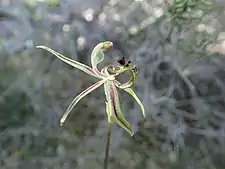Caladenia mesocera
Caladenia mesocera, commonly known as the narrow-lipped dragon orchid, is a species of orchid endemic to the south-west of Western Australia. It has a single erect, hairy leaf and usually only one greenish-yellow and red flower with a relatively long, insect-like labellum. Its distribution is further inland than that of most other caladenias.

| Narrow-lipped dragon orchid | |
|---|---|
 | |
| Caladenia mesocera growing near Lake King | |
| Scientific classification | |
| Kingdom: | Plantae |
| Clade: | Tracheophytes |
| Clade: | Angiosperms |
| Clade: | Monocots |
| Order: | Asparagales |
| Family: | Orchidaceae |
| Subfamily: | Orchidoideae |
| Tribe: | Diurideae |
| Genus: | Caladenia |
| Species: | C. mesocera |
| Binomial name | |
| Caladenia mesocera | |
| Synonyms[1] | |
|
Drakonorchis mesocera (Hopper & A.P.Br.) D.L.Jones & M.A.Clem. | |
Description
Caladenia mesocera is a terrestrial, perennial, deciduous, herb with an underground tuber and a single erect, hairy leaf, 40–80 mm (2–3 in) long and 4–10 mm (0.2–0.4 in) wide. Usually only one greenish-yellow and red flower 30–40 mm (1–2 in) long and 20–30 mm (0.8–1 in) wide is borne on a stalk 80–250 mm (3–10 in) tall. The dorsal sepal is bent backwards, 20–30 mm (0.8–1 in) long and 2–3 mm (0.08–0.1 in) wide. The lateral sepals are 18–25 mm (0.7–1 in) long, 2.5–6 mm (0.1–0.2 in) wide and spread widely. The petals are 15–24 mm (0.6–0.9 in) long and about 2 mm (0.08 in) wide and downswept. The labellum is 10–15 mm (0.4–0.6 in) long and 3–7 mm (0.1–0.3 in) wide, insect-like and stiffly hinged. It is densely hairy, greenish-yellow and red with a "false head" 2–3 mm (0.08–0.1 in) across at its highest point and there is a horn-like gland 2 mm (0.08 in) long either side of the "head". Flowering occurs from August to early October.[2][3][4]
Taxonomy and naming
Caladenia mesocera was first described in 2001 by Stephen Hopper and Andrew Phillip Brown and the description was published in Nuytsia.[1][5] The specific epithet (mesocera) is said to be derived from the Greek words meso meaning "middle" and ceras meaning "horn", referring to the position of the horn-like glands between the labellum claw and claw connection, a feature that readily distinguishes Caladenia mesocera from C. barbarossa.[5][6] The proper word for "middle" in ancient Greek is mesos (μέσος).[7]
Distribution and habitat
The narrow-lipped dragon orchid occurs between Bonnie Rock and Lake Moore east of Wubin, in the Avon Wheatbelt, Coolgardie, Geraldton Sandplains, Mallee and Yalgoo biogeographic regions where it grows near salt lakes and in other places that are moist in winter.[2][3][4][8]
Conservation
Caladenia mesocera is classified as "not threatened" by the Western Australian Government Department of Parks and Wildlife.[8]
References
- "Caladenia mesocera". APNI. Retrieved 21 February 2017.
- Jones, David L. (2006). A complete guide to native orchids of Australia including the island territories. Frenchs Forest, N.S.W.: New Holland. p. 99. ISBN 1877069124.
- Brown, Andrew; Dundas, Pat; Dixon, Kingsley; Hopper, Stephen (2008). Orchids of Western Australia. Crawley, Western Australia: University of Western Australia Press. p. 141. ISBN 9780980296457.
- Hoffman, Noel; Brown, Andrew (2011). Orchids of South-West Australia (3rd ed.). Gooseberry Hill: Noel Hoffman. p. 184. ISBN 9780646562322.
- Hopper, Stephen D.; Brown, Andrew Phillip (2001). "Contributions to Western Australian orchidology: 2. New taxa and circumscriptions in Caladenia". Nuytsia. 14 (1/2): 171–173. Retrieved 16 July 2019.
- Francis Aubie Sharr (2019). Western Australian Plant Names and their Meanings. Kardinya, Western Australia: Four Gables Press. p. 251. ISBN 9780958034180.
- Liddell, H.G. & Scott, R. (1940). A Greek-English Lexicon. Revised and augmented throughout by Sir Henry Stuart Jones with the assistance of Roderick McKenzie. Oxford: Clarendon Press.
- "Caladenia mesocera". FloraBase. Western Australian Government Department of Parks and Wildlife.